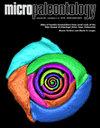1808年Eponides Montfort(底栖有孔虫目)的地层记录,贯穿新特提斯北部边缘的古新世碳酸盐
IF 1.6
4区 地球科学
Q3 PALEONTOLOGY
引用次数: 1
摘要
在出现古新世浅水灰岩序列的前新特提斯北部边缘(奥地利、土耳其和伊朗),发现了与埃波尼德斯非常相似的形态型。这些有孔虫是层状穿孔的,具有一套斜螺旋状排列的梯形腔室。我们通过对碳酸盐岩薄片进行详细的建筑分析来测试它们的一般鉴定,在这些碳酸盐岩薄片中发现了大量的类eponides标本。本研究显示出现双分体、拱形间隔和由腔室腹端融合形成的假脐。这些特征使我们能够将标本识别为埃波尼德斯,尽管还没有尝试过具体的归属。简要讨论了晚白垩世和新生代Eponides及其系统发育相关亲缘的演化模式。本文章由计算机程序翻译,如有差异,请以英文原文为准。
Stratigraphic record of Eponides Montfort 1808 (benthic Foraminifera) through the Paleocene carbonates of the northern Neotethys margin
In the former northern Neotethys margin where Paleocene shallow-water limestone successions crop out (Austria, Turkey and Iran), morphotypes closely resembling Eponides have been recognized. These foraminifers are lamellar-perforated, with a trochospirally arranged set of trapezoidal chambers.We have tested their generic identification through a detailed architectural analysis of thin sections of carbonate rocks in which Eponides-like specimens have abundantly been recovered. This study shows the occurrence of bipartitor, arched septa and a pseudoumbilicus formed by the fusion of ventral ends of chambers. These features allow us to identify the specimens as Eponides, although the specific attribution has not been attempted. The evolutionary pattern displayed by the Late Cretaceous and Cenozoic Eponides and phylogenetically-related allies is briefly discussed.
求助全文
通过发布文献求助,成功后即可免费获取论文全文。
去求助
来源期刊

Micropaleontology
地学-古生物学
CiteScore
3.20
自引率
6.70%
发文量
18
审稿时长
>12 weeks
期刊介绍:
The Journal of Micropalaeontology (JM) is an established international journal covering all aspects of microfossils and their application to both applied studies and basic research. In particular we welcome submissions relating to microfossils and their application to palaeoceanography, palaeoclimatology, palaeobiology, evolution, taxonomy, environmental change and molecular phylogeny. Owned by The Micropalaeontological Society, the scope of the journal is broad, demonstrating the application of microfossils to solving broad geoscience issues.
 求助内容:
求助内容: 应助结果提醒方式:
应助结果提醒方式:


